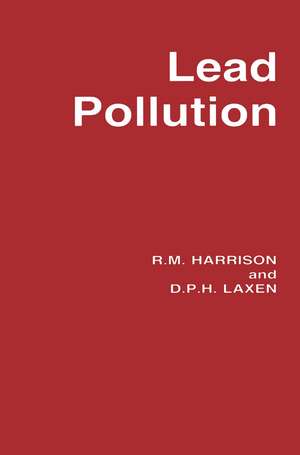Lead Pollution: Causes and control
Autor Roger Harrisonen Limba Engleză Paperback – 4 mai 1984
Preț: 381.43 lei
Nou
Puncte Express: 572
Preț estimativ în valută:
72.99€ • 78.05$ • 60.85£
72.99€ • 78.05$ • 60.85£
Carte tipărită la comandă
Livrare economică 17 aprilie-01 mai
Preluare comenzi: 021 569.72.76
Specificații
ISBN-13: 9780412258800
ISBN-10: 0412258803
Pagini: 168
Ilustrații: VIII, 168 p.
Dimensiuni: 155 x 235 x 10 mm
Greutate: 0.26 kg
Ediția:Softcover reprint of the original 1st ed. 1984
Editura: Springer Us
Colecția Springer
Locul publicării:New York, NY, United States
ISBN-10: 0412258803
Pagini: 168
Ilustrații: VIII, 168 p.
Dimensiuni: 155 x 235 x 10 mm
Greutate: 0.26 kg
Ediția:Softcover reprint of the original 1st ed. 1984
Editura: Springer Us
Colecția Springer
Locul publicării:New York, NY, United States
Public țintă
ResearchCuprins
1 Introduction.- References.- 2 Lead in the atmosphere.- 2.1 Introduction.- 2.2 Sources of lead in air.- 2.3 Concentrations of lead in ambient air.- 2.4 Particle size distributions.- 2.5 Chemical properties of atmospheric lead.- References.- 3 Lead in water.- 3.1 Introduction.- 3.2 Sources of lead in surface waters.- 3.3 Concentrations of lead in water.- 3.4 Chemistry of lead in water.- References.- 4 Lead in soils.- 4.1 Introduction.- 4.2 Sources of lead in soil.- 4.3 Concentrations of lead in soil.- 4.4 Uptake of soil lead by living organisms.- 4.5 Chemistry of lead in soils.- 4.6 Lead in street dusts.- References.- 5 Control of lead in air.- 5.1 Industrial sources of lead.- 5.2 Control of industrial emissions of lead.- 5.3 Legislative regulations affecting industrial lead emissions.- 5.4 Control of lead emissions from motor vehicles.- 5.5 Ambient air quality standard for lead.- 5.6 Control of lead within the workplace.- References.- 6 Control of lead discharges to water.- 6.1 Introduction.- 6.2 Water quality criteria and standards.- 6.3 Uniform emission standards versus water quality objectives.- 6.4 Control practices for lead discharges.- References.- 7 Human exposure to lead and its effects.- 7.1 Introduction.- 7.2 Sources and intake of lead.- 7.3 Uptake of lead.- 7.4 Metabolism of lead.- 7.5 Blood leads.- 7.6 Biological and adverse health effects of exposure to lead.- References.- 8 Chemical analysis of lead in the environment.- 8.1 Introduction.- 8.2 Chemical analysis of lead: available techniques.- 8.3 Sampling and analysis of environmental media.- 8.4 Contamination during lead analysis.- References.










